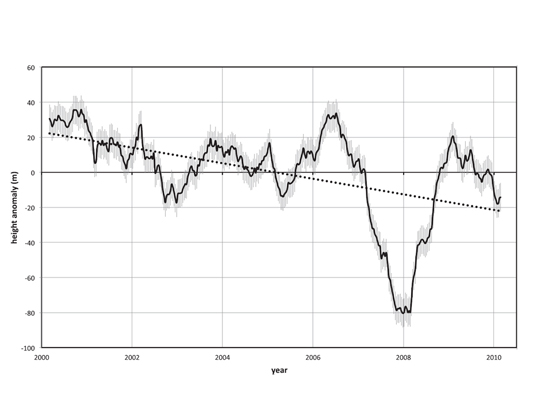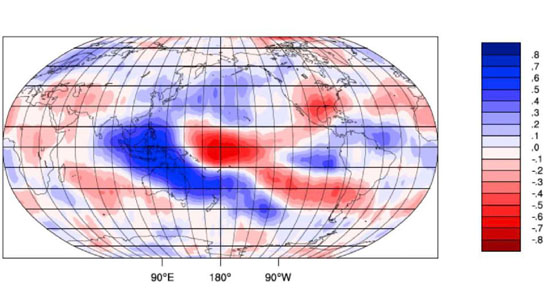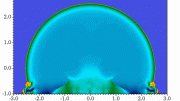
This image of clouds over the southern Indian Ocean was acquired on July 23, 2007, by one of the backward (northward)-viewing cameras of the Multi-angle Imaging SpectroRadiometer (MISR) instrument on NASA’s polar-orbiting Terra spacecraft. The area covered by the image is 247.5 kilometers wide and 660 kilometers long, and is shown in an approximate perspective view at an angle of 60 degrees off of vertical. The solar zenith angle ranges from about 83 degrees at the top of the image to 88 degrees at the bottom, hence the lengthening of shadows cast by the clouds on the underlying ocean surface and reddening of the hues in the foreground. Stereoscopic analysis of the data from multiple MISR cameras indicates that the cloud tops visible here range in altitude from about 0.6 to 2.5 miles (1 to 4 kilometers). A new university study using MISR data revealed an overall trend of decreasing global cloud height during the last decade. Credit: NASA/JPL-Caltech
Researchers analyzed NASA satellite data from 2000 – 2010 and found that the global average cloud height declined by around one percent over the decade, or by around 100 to 130 feet. Long-term monitoring will be required to determine the significance of the change, but the researchers believe this may be a possible reaction to global warming.
Earth’s clouds got a little lower — about one percent on average — during the first decade of this century, finds a new NASA-funded university study based on NASA satellite data. The results have potential implications for future global climate.
Scientists at the University of Auckland in New Zealand analyzed the first 10 years of global cloud-top height measurements (from March 2000 to February 2010) from the Multi-angle Imaging SpectroRadiometer (MISR) instrument on NASA’s Terra spacecraft. The study, published recently in the journal Geophysical Research Letters, revealed an overall trend of decreasing cloud height. Global average cloud height declined by around one percent over the decade, or by around 100 to 130 feet (30 to 40 meters). Most of the reduction was due to fewer clouds occurring at very high altitudes.

Data from NASA’s MISR instrument on NASA’s Terra spacecraft show that global average cloud height declined by about 1 percent over the decade from 2000 to 2010, or around 100 to 130 feet (30 to 40 meters). The graph here shows anomalies in global effective cloud-top height from the 10-year average, corrected to account for seasonal differences. The solid line represents the 12-month running average of 10-day anomalies, while the dotted line represents the trendline calculated by linear regression. Gray error bars indicate the sampling error (plus or minus 26 feet, or 8 meters) in the annual average. Credit: University of Auckland/NASA JPL-Caltech
Lead researcher Roger Davies said that while the record is too short to be definitive, it provides a hint that something quite important might be going on. Longer-term monitoring will be required to determine the significance of the observation for global temperatures.
A consistent reduction in cloud height would allow Earth to cool to space more efficiently, reducing the surface temperature of the planet and potentially slowing the effects of global warming. This may represent a “negative feedback” mechanism – a change caused by global warming that works to counteract it. “We don’t know exactly what causes the cloud heights to lower,” says Davies. “But it must be due to a change in the circulation patterns that give rise to cloud formation at high altitude.”
NASA’s Terra spacecraft is scheduled to continue gathering data through the remainder of this decade. Scientists will continue to monitor the MISR data closely to see if this trend continues.

Patterns that relate changes in cloud-top height with El Niño/ La Niña indicators. Regions in blue show where cloud heights rise during La Nina conditions, while regions in red show where they fall. The darker the color, the stronger the relationship. Credit: University of Auckland/NASA JPL-Caltech
MISR, built and managed by NASA’s Jet Propulsion Laboratory, Pasadena, California, is one of five instruments on NASA’s Terra spacecraft, launched in December 1999. The instrument uses nine cameras at different angles to produce a stereo image of clouds around the globe, allowing measurement of their altitude and movement.
Another NASA mission that studies clouds is NASA’s CloudSat, also built by JPL and launched in 2006. CloudSat is the first satellite that uses an advanced radar to “slice” through clouds to see their vertical structure, providing a completely new observational capability from space. CloudSat’s primary goal is to furnish data needed to evaluate and improve the way clouds are represented in global models, thereby contributing to better predictions of clouds and thus to their poorly understood role in climate change and the cloud-climate feedback.









Be the first to comment on "Earth’s Clouds are Getting Lower, May be in Response to Global Warming"